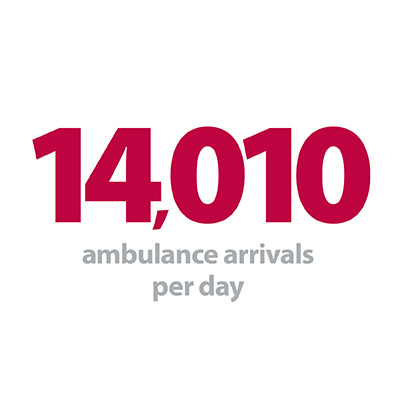


Week eight of the winter sitreps follows a similar pattern to last week, as high demand is met by a resolute response from trusts, and performance remains stable. Flu and norovirus continue to be less prevalent than last year, but as temperatures fall we could see additional pressure on the service in February.
Key indicators this week include:
- Bed occupancy is stable at 94.6%, still very high but no change from last week, and 0.5% lower than the same week last year.
- Escalation beds dropped slightly this week to 3,630 - around 900 less than the same week last year.
- Total beds open is also very similar to last week at 97,549, again lower than last year.
- Length of stay data was mixed this week. The number of patients staying longer than 7 and 14 days were up slightly, but the number of patients staying longer than 21 days was down by 0.7%. The number of people staying 7 days or more and 21 days or more are considerably lower than at the same point last year.
- There was a reduction in beds closed with D&V and norovirus this week. A decrease of 6.5% to 530 beds this week. This equates to 142 fewer closed beds than the same week last year.
- There were 25 A&E diverts this week, down from 35 last week.
- Ambulance arrivals rose slightly this week by 0.5% to 98,072, still much higher (by 5.1%) than the same point last year.
- The proportion of ambulance arrivals with delayed handovers increased slightly this week, with the 30 minute delays up by 0.5% to 12.2%, and the 60 minute delays up by 0.5% to 2.6%. Both of these are slightly higher than the same week last year.
High demand is met by a resolute response from trusts, and performance remains stable.
tweet this
Acute bed occupancy has remained above 93% for the last month, and as acuity increases over the winter period this limits the options available to maintain patient flow. In the past week, 101 trusts with an A&E department (out of 134) were running at 95% bed occupancy or higher at some point. However, the fact that there has been a fall in the number of escalation beds open this week (along with the favourable comparison to the number open at the same point last year) gives an indication of the direction of travel and some confidence in trusts’ position last Sunday.
As discussed in our previous blogs, length of stay data points to the efforts trusts are making to appropriately discharge and support patients away from the hospital. Small increases in the number of patients staying over 7 and 14 days this week were offset by a reduction in the key 21-day metric where trusts have been focussing their efforts. There are now over 2,200 fewer long stay patients compared to this time last year.
Ambulance arrivals are still at a far higher level than last year, with over 14,000 arrivals per day this week. The improvements in handover delays seen earlier in the winter compared to last year are less noticeable, with arrivals delayed by both 30 and 60 minutes now higher than the same week last year, the first time we have seen this in 2018/19. However, considering the increase in the total number of arrivals this year, there are still far more patients entering the hospital system from ambulances in less than 30 minutes – this week 3,890 more ambulance arrivals were handed over within 30 minutes compared to the same week last year. It should be noted that NHS Improvement recommends that handover delays should not exceed 15 minutes, but without the publication of this data within the winter sitreps, we are unable to see the total number of patients who are impacted by handover delays.
In the past week, 101 trusts with an A&E department (out of 134) were running at 95% bed occupancy or higher at some point.
In summary the weekly sitreps this year so far show some clear steps forward from last winter, but this may not be felt by frontline staff on the ground who often go above and beyond to meet the challenges in their workplace on a daily basis. As temperatures fall below freezing, and we brace ourselves for worsening conditions in the week ahead, trusts will be doing all they can to maintain both their operational performance and staff moral. Staff and trusts will be hoping that ‘winter’ finishes at the end of February and that conditions don’t roll over into spring like last year.
For a more detailed breakdown of this week’s winter sitrep data please see our summary dashboard.
Trusts working hard to maintain winter performance but not out of the woods yet
Responding to the latest weekly winter performance data from NHS England, NHS Providers director of policy and strategy, Miriam Deakin said:
"We are now over halfway through the winter reporting period, and NHS trusts are continuing to work hard to cope with winter pressures. It is testament to their hard work that services are performing better than at this point last year.
"Efforts to reduce the number of patients staying in hospital for long periods have played a particularly important role in better performance so far this winter.
"But health and care services remain severely stretched. The number of beds in use remains very high at 94%, while the number of patients arriving by ambulance shows no sign of slipping. We are also fortunate that flu and norovirus isn’t as prevalent this year.
"We are not out of the woods yet. This week has seen the coldest day of winter so far. The introduction of freezing temperatures will inevitably lead to additional pressure.”